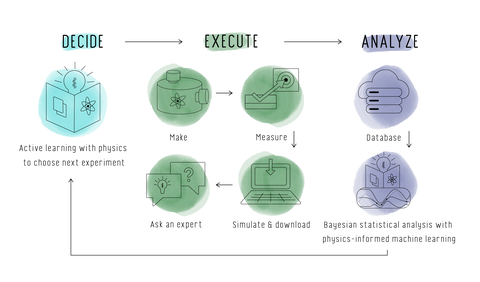Autonomous Methods

CAMEO is capable of searching for new materials by operating in a closed loop. The AI determines which experiment to run on a material, does the experiment and collects the data. One cycle through the experiment can take from seconds to tens of minutes.
Development of methods for autonomous materials synthesis, characterization, and analysis to maximize generation of new knowledge with minimal experimentation — There are many areas in material science research where the search space is too large or too expensive to comprehensively measure. For example, the search space of alloy composition grows exponentially with the number of components; at 3 components it can be cumbersome to measure even with quick measurements. Furthermore, in user facilities such as neutron or x-ray beamlines, the experiments can be costly (in both time and financially) to perform, thus it is important for each experiment to be chosen carefully.
These challenges are the drivers behind our efforts in autonomous methods, which are used by our stakeholders and within our own Autonomous and AI-Driven Systems. The algorithms tackle two challenges: 1) analyzing past data both experimental and computational, and 2) using analysis results to target the most informative experiments and measurements to perform next. Key to the success of these algorithms is their ability to output physically meaningful results. This is achieved through the use of Scientific AI principles to incorporate into the algorithms prior physical knowledge of the experimental process, the equipment used, and the target material system. We focus on probabilistic methods that provide machine learning outputs with quantified uncertainty - a fundamental need in making appropriate decisions in the lab.
Additionally, subject domain experts often have knowledge or intuition that we would like to incorporate. Our algorithms allow for Human-In-The-Loop interactions - providing 1) real-time interpretable visualization that allow the expert to follow AI-reasoning, and 2) a graphical user interface with which the expert can incorporate their knowledge.
Example algorithms for autonomous experiments include CAMEO: Closed-loop Autonomous Materials Exploration and Optimization, ANDiE: Autonomous Neutron Diffraction Explorer, etc. CAMEO combines prior knowledge of X-ray diffraction theory and phase map physics among others. It was used to guide synchrotron X-ray diffraction measurements toward the discovery of the new best-in-class phase change memory material. ANDiE combines knowledge of magnetics and neutron scattering physics and provides a 5-fold acceleration of neutron scattering characterization of magnetic material order parameters.
Beyond individual autonomous systems, we develop algorithms for full autonomous facility control, with a focus on materials research labs. We have developed a multi-agent framework in which Scientific AI agents with different capabilities work together to optimize the use of facility resources while also accelerating research campaigns. MULTITASK: MULTI-agent auTonomous fAcilities - a Scalable frameworK, was demonstrated accelerating materials optimization in a simulated laboratory.
Projects
- CAMEO: Closed-loop autonomous materials exploration and optimization
- ANDiE: Autonomous Neutron Diffraction Explorer
- MULTITASK: MULTI-agent auTonomous fAcilities - a Scalable frameworK

